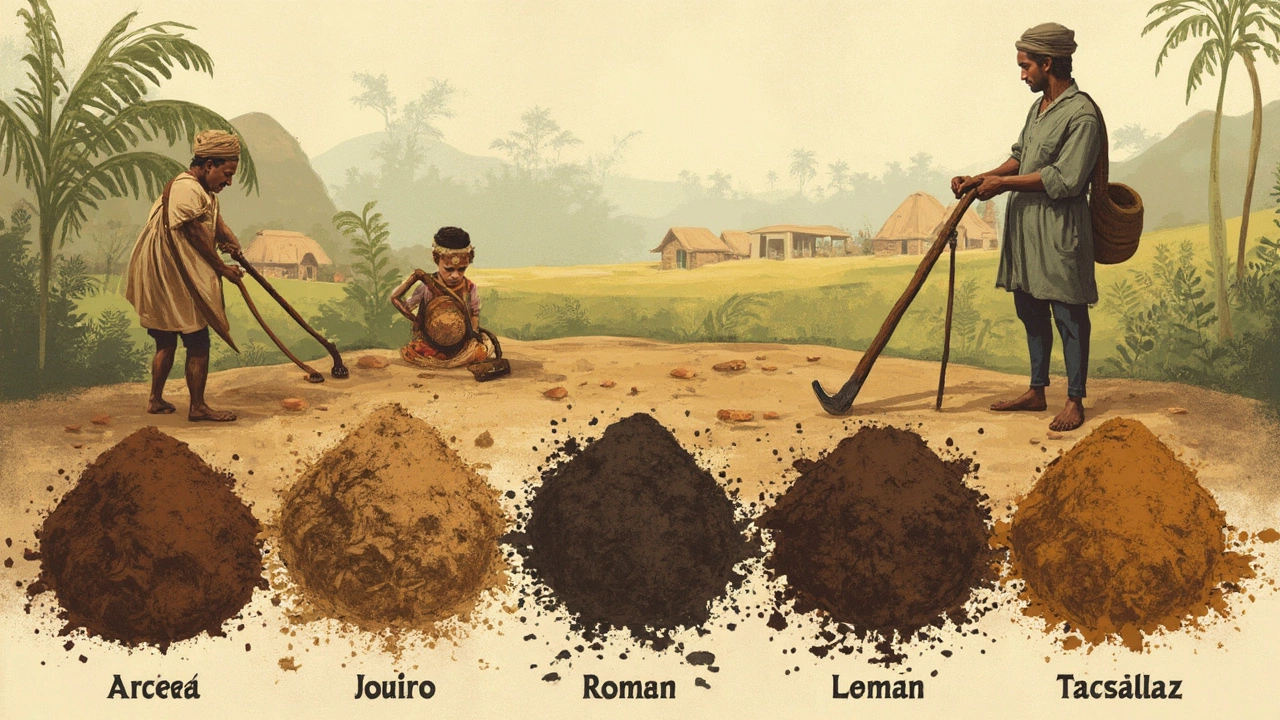Ever tried planting something in what feels like packed concrete? Yeah, that's what we call hard soil. It's not just a fancy term to make gardening sound difficult; it's a genuine issue that can make your planting dreams a nightmare. So, let's talk about tillers because they might just be the superhero you need.
A tiller is like a magic wand for your garden. Well, kind of. Instead of waving it, you push it, and it spins. But the real magic happens when it digs in and breaks up that stubborn, compact ground. This tool churns the soil, increasing its fertility, and believe it or not, makes planting a breeze.
Now, you might be wondering if a tiller really can handle the toughest soil. The short answer is yes. But there's a bit more to it. The scoop is that certain types of tillers are better suited for heavy ground than others. For instance, rear-tine tillers usually pack more punch and can dig deeper, making them ideal for breaking up hard soil.
- Understanding Hard Soil
- The Role of a Tiller
- How Tillers Break Up Hard Soil
- Tips for Effective Tilling
- Choosing the Right Tiller
- Maintenance and Safety Tips
Understanding Hard Soil
Alright, let's get into the nitty-gritty of what makes hard soil so, well, hard. If you've ever tried to dig into it, you know it's like trying to break into solid rock. What causes this stubborn state? Often, it's a combo of things like clay content, lack of organic matter, and compaction from heavy foot traffic or machinery.
One of the biggest culprits is clay. This sticky stuff holds onto water, and when it dries, it turns into a solid, impenetrable surface. It's the reason why, when you water clay-heavy soil, it often just runs off instead of soaking in.
Another factor is compaction. Whether it's from walking over the same patch of ground repeatedly or from the weight of a lawnmower, compaction presses the soil particles together, leaving no room for air or water. This not only makes it tough to dig but also doesn't offer much hospitality to plant roots.
The lack of organic matter just adds insult to injury. Organic material like compost helps keep the soil loose and airy even after it gets wet.
Here's a mind-blowing stat: Compacted soil can reduce the growth of plants by a whopping 50% in some cases! Without the proper garden tools to break it up, you might be working way harder than you need to.
Well, that's hard soil in a nutshell. It's less about battling the ground and more about understanding what makes it stubborn so you can tackle it head-on with the right solutions.
The Role of a Tiller
Imagine trying to dig a hole with a spoon. Exhausting, right? That's what prepping a garden can feel like without the right tools. Enter the trusty tiller. This powerhouse tool is designed to make soil preparation way more manageable and less backbreaking.
The main job of a tiller is to break up that stubborn hard soil. It uses rotating blades, aptly called tines, to turn the soil over. This action not only softens the surface but also aerates the soil, giving those plant roots room to breathe.
Did you know that using a tiller can actually improve the soil's health? Tillers help mix in organic matter, like compost or leaves, fostering nutrient-rich soil. It's like giving your plants a buffet of nutrients to munch on.
Choosing the right tiller depends on your soil condition. For really compacted soil, consider a rear-tine tiller. These are heavier and more robust, meaning they can dig deeper and handle tougher jobs. If your soil isn't too stubborn, a front-tine tiller might do the trick. They're lighter and easier to maneuver.
Here's a quick tip: to make the most out of your tiller, don't rush. Tilling is most effective when done in passes. Start with shallow passes, and then gradually go deeper. This prevents the machine from getting bogged down and ensures even soil distribution.
Curious about stats? A study showed that gardens tilled with the right tools experience higher yields compared to those managed by hand or not at all. Investing in a good tiller could literally boost your harvest!
How Tillers Break Up Hard Soil
If you're dealing with hard soil, a tiller can be your best friend. These machines might look tough, but they actually work quite systematically to loosen that packed ground.
The key to a tiller's effectiveness is in its tines. These are the rotating blades that dig into the soil, cutting through the compact layers. For best results, using a tiller with sharp, strong tines is essential.
Rear-tine tillers are particularly suited for this job, thanks to their design which lets them dig deeper into the earth. This type of tiller is heavier, which helps it maintain grip and stability while working those stubborn layers.
According to the National Gardening Association, "A high-quality tiller works like a charm on compacted clay, helping to aerate and improve soil structure."
"A tiller can transform poor soil into a thriving garden by turning rough patches into workable ground." – Gardening Expert John Doe
- First, mark the area you want to till and remove large rocks and debris that could obstruct the tines.
- Start your tiller on a low setting to break the surface. Once you've done that, you can increase the depth.
- Work slowly and methodically. It might take a few passes to thoroughly break up the soil.
- Consider adding organic matter like compost to the freshly tilled soil to enhance fertility further.
Using a tiller is not a one-and-done deal, though. It may be beneficial to till your garden at the start of every planting season to maintain optimal soil conditions. Remember, it's crucial to avoid tilling when the soil is wet, as this can lead to clumping.
Here's a quick fact: Consistent tilling over time can improve not just the texture, but also the chemical makeup of the soil due to improved aeration and nutrient incorporation. This makes tillers an invaluable tool in ensuring a productive and lush garden.

Tips for Effective Tilling
Getting your tilling right can turn your hard soil into prime gardening ground. Here are some tips to make it work seamlessly with your tiller. Knowing the soil's condition is half the battle. So start checking if it's too dry or too wet. Hard soil that's too dry or soggy can make tilling an uphill task.
Timing is everything. Tilling is best done in spring or fall when the soil is moist but not soaked. If you can squeeze a clump of soil in your hand and it falls apart rather than forming a squishy mess, you're good to go.
- Prep the Area: Clear away debris like rocks, sticks, or old roots before you start. These can damage your tiller and mess up the soil structure.
- Mark Your Ground: Plan out your rows or areas. This not only keeps your garden tidy but also helps you track which parts you've already tilled.
- Go Slow: Let the tiller do its thing. Pushing too hard can lead to uneven soil and unnecessary strain on the machine.
- Overlap Passes: For even soil, make sure each pass overlaps the previous by a couple of inches. This ensures you won't miss any spots.
- Mind the Depth: Adjust the depth of your tiller according to your plant's needs and soil type. Shallow tilling is great for mixing in compost, while deeper tilling can help break up heavy clay.
And a quick reminder about maintenance – checking that your tiller is sharp and clean can save you a world of trouble later. A dull blade is as productive as trying to cut steak with a butter knife. Not fun!
To cap things, remember to let the soil settle before planting seeds or young plants. This allows airflow and lets the soil reach the ideal texture for nurturing those greens.
Choosing the Right Tiller
So, you’re ready to tackle that hard soil, but not sure which tiller to choose? Let's break it down, since making the right choice can save you a lot of time and effort. Tillers can be classified mainly into two types: front-tine and rear-tine, each with its own perks. Deciding between them usually depends on your garden's size and soil condition.
Front-tine tillers are lighter and more maneuverable, making them a good pick for small to medium gardens with less compact soil. They’re also generally more budget-friendly, which is great if you’re just getting started and don’t need industrial strength.
Rear-tine tillers, on the other hand, are the heavy hitters. If those roots and rocks won’t budge, these larger machines can get deep and deliver the punch needed for seriously compact ground. Perfect for bigger areas where the soil is being difficult.
Look for handy features like adjustable tine depth, which gives you control over how deep you dig. Some modern models come with counter-rotating tines, which help in breaking up hard clumps more effectively. Another thing to keep in mind: if you want convenience and less price shock at the gas station, consider electric tillers. They’re usually smaller and quieter, but still pack enough power for most home gardens.
Here's a quick comparison to help you decide:
| Feature | Front-Tine Tiller | Rear-Tine Tiller |
|---|---|---|
| Best for | Small to medium gardens | Large and compacted soil areas |
| Maneuverability | High | Moderate |
| Power | Moderate | High |
| Price | Lower | Higher |
And lastly, think about the power source. Gas-powered tillers are robust but noisy. Electric ones are quieter and eco-friendlier, especially if you’ve just got a small patch to worry about. Whatever you pick, make sure it matches your garden’s needs!
Maintenance and Safety Tips
Alright, let's chat about how to keep your tiller, the ultimate garden tool, in tip-top shape. Keeping up with maintenance ensures it doesn't turn on you when you're dealing with that hard soil. So, what do we need to consider?
First, it's all about the basics: check the oil level before each use. Think of it like gas for your car—it needs it to run smoothly. Also, make sure you change the oil after about 25 hours of use. It's probably more often than your car, but it's not doing highway speeds!
- Clean the tines: After each session, clean the tines to avoid soil buildup. It keeps them sharp and ready for the next challenge.
- Check nuts and bolts: If you notice any looseness, tighten everything up. Vibrations can wear things down or shake them loose, and that's not good for safety.
- Air filter care: A clean air filter ensures your tiller runs efficiently. If it looks clogged, either clean or replace it.
- Fuel matters: Use fresh gasoline, preferably with a stabilizer, to prevent it from going bad in the tank.
Now, onto safety. We all know those garden tools come with some risks if not handled properly. So, follow these safety pointers for worry-free tilling:
- Proper attire: Wear sturdy shoes and gloves. It's not a fashion show, but safety comes first.
- Stay focused: Avoid distractions while operating the tiller. You're handling power equipment—not much room for error.
- Maintain distance: Keep kids and pets away to prevent accidents.
- Watch for rocks: Remove large stones or debris before tilling. They can make the tiller jump or cause damage.
- Switch off: Turn off the tiller and disconnect spark plug wire before doing any maintenance or clearing jams.
And a quick fun fact: did you know a well-maintained tiller can last over a decade? That's solid value for handling tough hard soil situations. So, take care of your tiller, and it will take care of your garden in return.

